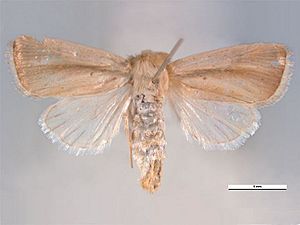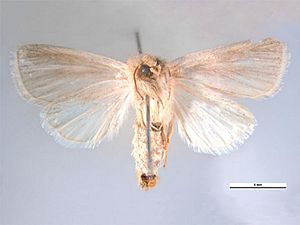Asiatic pink stem borer facts for kids
Quick facts for kids Asiatic pink stem borer |
|
|---|---|
 |
|
| Dorsal view | |
 |
|
| Ventral view | |
| Scientific classification | |
| Synonyms | |
|
The Asiatic pink stem borer is a type of moth. Its scientific name is Sesamia inferens. People also call it the pink borer or purple stem borer. This moth was first described in 1856 by Francis Walker. You can find it in many parts of Asia, from Pakistan to Japan and even the Solomon Islands. It's known as a big pest because its caterpillars eat many different kinds of plants, especially important crops.
Contents
What the Moth Looks Like
The Asiatic pink stem borer moth has a wingspan of about 28 millimeters (just over an inch). Its body is a yellowish-brown color. The front wings often have a reddish-brown shade along the middle veins. The back wings are usually whitish.
The Caterpillar (Larva)
The caterpillar of this moth is smooth and shiny. It doesn't have a lot of obvious hairs or markings. Its color can change, but it's usually creamy white with a clear pink tint. The head and the shield-like part behind its head are brown. The back part of its body, near where waste leaves, is yellowish-brown.
When fully grown, these caterpillars are about 30 to 40 millimeters long. They are pink with buff and pink patterns on their back. Their head stays brown.
The Pupa
The pupa is the stage between the caterpillar and the adult moth. It is about 18 millimeters long. It looks brown to yellowish-brown. The front of its head area is wrinkled. The very end of its body has four large and two small spines.
What They Eat
The caterpillars of the Asiatic pink stem borer mostly eat plants from the Poaceae family. This family includes many types of grasses and grains. Some of the plants they eat are:
- Coix (Job's Tears)
- Echinochloa (Barnyard grass)
- Oryza (Rice)
- Panicum (Millet)
- Saccharum (Sugarcane)
- Setaria (Foxtail millet)
- Triticum (Wheat)
- Zea (Corn or Maize)
- Zizania (Wild rice)
Many of these plants are very important for food and farming around the world. This is why the moth is considered a major pest.
Signs of Damage
The caterpillars mainly bore into the stems of rice plants. They also bore into the base of the panicle, which is the part of the plant that holds the grains.
When they attack the stem, the plant can wilt. This causes a "deadheart," meaning the central shoot dies and turns brown. If they attack the panicle, it can be cut off. This leads to a "whitehead," where the panicle turns white and empty.
These signs of damage can look similar to what other stem borers cause. So, farmers need to look closely to figure out which pest is causing the problem.
How to Control Them
Farmers use different methods to control the Asiatic pink stem borer:
Mechanical Control
- Hand picking: People can pick the caterpillars off plants by hand.
- Pheromone traps: These traps use special scents (pheromones) to attract and catch male moths.
Cultural Practices
- Crop rotation: Farmers plant different crops in the same field each season. This can break the pest's life cycle.
- Reducing water levels: Changing the amount of water in rice fields can make it harder for the borers to survive.
Natural Enemies
Using natural enemies is a very eco-friendly way to control pests.
- Parasitoids: These are insects that lay their eggs inside or on other insects, eventually killing them.
- Trichogramma minutum and Telenomeus species: These tiny wasps can be introduced to eat the borer's eggs.
- Apanteles flavipes, Bracon chinensis, and Sturmiopsis inferens: These are effective against the caterpillars.
- Xanthopinpla species and Tetrastichus aygari: These are used to control the pupae.
Chemical Control
Sometimes, farmers use special sprays or granules to kill the borers. Some chemicals that have been used include:

